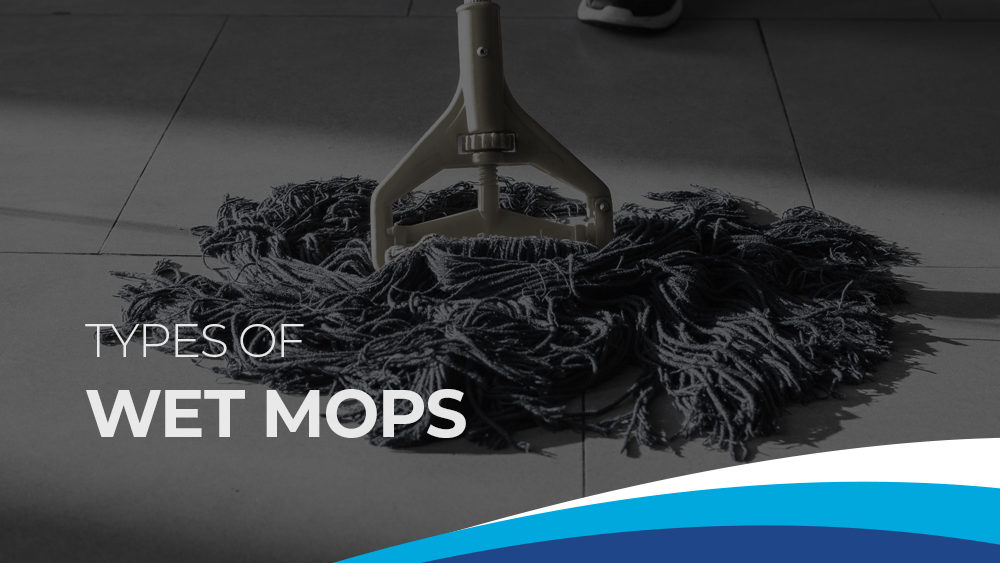Wet mopping is among the most effective cleaning process for the control of heavy dirt and dust. In heavy traffic areas during wet weather or in places where disinfectants or germicides are used, the wet mop is the perfect tool. Premier Mop & Broom offers a wide variety of wet mop designs and fibers for any wet or damp cleaning job.
LOOPED END WET MOPS
Initially, looped end mops are a little expensive but their superior quality means substantial improvement in both life and performance. The continous loop construction has several advantages over cut-end mops. It provides higher retention of liquids and faster break-in. Since linting and de-plying are virtually eliminated, mops last much longer, yarns have a looser, more absorbent twist resulting in cleaner floors with less labor.
Advantages of Looped-End Mops
- More durable than cut end mops
- Looped ends prevent unraveling
- Machine washable, except for cotton and poly-cotton blends
CUT END WET MOPS
These economical mops are our most popular mop styles. Our wide variety of yarns, sizes and features assures a mop for every need.
Advantages of Cut-End Mops
- More absorbent than looped end mops
- Durable yet economical
- Ideal for soaking up spills
MICROFIBER WET MOPS
Advantages of Microfiber Mops
- Designed to remove tiny dust particles
- Absorbs up to seven times its weight in liquid
- Hypoallergenic and non-abrasive
- Reduce the use of chemicals, water and energy
YARNS
Cotton, rayon, synthetics and blend all have particular characteristics that make them more suited for one job than another. The table below gives advantages and disadvantages for each type of yarn and suggest the best likely usage of them.
| YARN | ADVANTAGES | DISADVANTAGES | USES |
|---|---|---|---|
| Cotton | Good absorption and retention Low initial cost Limited Shirinkage |
Requires break-in Lints and dries slowly promoting mildew & deterioration |
General Use Picking up liquids Scrubbing |
| Rayon | Quick absorption & release Dries fast, mildew resistant Cleaner yarn, lint less |
Shrinks when laundered Less liquid retention |
Applying liquids (finishes, disinfectants, etc.) |
| Synthetics | Long staple fiber for superior tensile strength | Higher cost Poor absorption |
Clean rooms Rough surfaces |
| Blends | Ideal balance for price, performance and durability | May shrink (unless pre-shrunk) | Healthcare, contractors and other high-end users |
YARN PLY
Yarn ply indicates the number of strands twisted together to make a single yarn. More plies give added strength although hihg ply numbers do not necessarily mean higher quality yarn. More strands may add strength but they may also decrease absorbency. It is better and more cost-effextive to choose a higher qulaity yarn than a high-ply, low quality yarn.
SIZE
The operators physical size and strength should properly match the suggested mop size to prevent worker fatigue and low productivity.
| OPERATOR SIZE | MOP SIZE |
|---|---|
| 100 – 130 lbs | SMALL (10-12 oz) |
| 128 – 155 lbs | MEDIUM (14-16 oz) |
| 145 – 175 lbs | LARGE (22-24 oz) |
| 160 – Larger | X-LARGE (28-32 oz) |
ABSORBENCY
The operators physical size and strength should properly match the suggested mop size to prevent worker fatigue and low productivity.
- Small mop heads typically hold 8 – 10 oz. of liquid
- Medium mop heads typically hold 16 – 20 oz. of liquid
- Large mop heads typically hold 24 – 32 oz. of liquid
- Extra-Large mop heads typically hold 32 – 40 oz. of liquid
Wet Mop Care and Mop Storage
Proper care and maintenance of your wet mop can help it last up to five times longer. Plus, the mop will more effectively clean if it’s regularly maintained.
- Clean the mop’s head thoroughly in warm water before mopping to make sure that any leftover chemicals are rinsed out. This will help reduce the risk of cross contamination.
- Don’t twist the mop head when it’s in the mop wringer to prevent the strands from loosening.
- Soak the mop head in hot water for up to 10 minutes after you are finished mopping, and then rinse. This helps keep the mop head clean while preventing cross contamination.
- Never leave a mop in dirty mop water overnight. This can create a breeding ground for bacteria, mold, and mildew, and it may also weaken the mop fibers.
- When storing mops, hang them with the head up after it has dried to prevent mold formation.
- Machine launder applicable mop heads on a regular basis, as this will help prevent them from breaking down. It is not recommended to wash cut end mops, as they are likely to tangle in the wash.
- Do not use bleach when washing your microfiber wet mops as this will break down the fibers. Use a mild disinfectant.






Comments are closed.